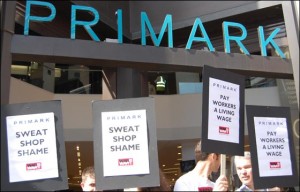Being from the UK, Primark is a big part of Students and Teenagers culture. It is a low cost clothing shop, with basic and fashionable clothing items. In 2008, Primark went through a scandal of being accused of using child labour in India, paying a mere 60cents a day to children working exceptionally long hours.
Hundreds of Protesters stood outside the clothing shops all around the UK, and shouted “sweatshop shame” and “pay workers a living wage”.
Interestingly, sales didn’t change in quantity during the time, or even after the time of the protests. Indubitably, most people who shop at Primark would have known about the accusations that were also backed up with evidence.
So, -why do shoppers continue to shop at Primark, knowing of the unethical treatment of its manufacturers?
I believe this is a case of perception vs. reality. People agreed and said they were shocked by the child workers and the payment they received, however they did not alter their consumption patterns. This could hardly be due to customer loyalty; but rather to ignorance of consumers. While Primark’s public image wasn’t preserved, their profit and market share remained in tact.
This shows how consumers get what they want, disregarding how they were attained. Thus, as the title of this blog already states: perception vs. reality plays a large role here, as what consumers let others believe their opinions are, may not indeed be their opinions at all, they are just attempting to crowd follow and not be frowned upon.
This case shows exactly how consumer’s work and that any business can succeed even with scandals and unethical behaviour – this needs to change.
“‘Sweatshops’ Protest Hits Primark.” War On Want. Ed. Paul Collins. N.p., 23 June 2008. Web. 06 Nov. 2014. <http://www.waronwant.org/news/press-releases/16133-sweatshops-protest-hits-primark>.
